Breaking-Down and Parameterising Wave Energy Converter Costs Using the CapEx and Similitude Methods
Abstract
1. Introduction
- (a)
- The manual cost estimation of large WEC configuration-location databases is time-demanding.
- (b)
- CapEx is often defined for a fixed design of WEC and WEF by first distinguishing the CapEx from the WEF costs, and second by providing a breakdown of CapEx into its main components [31,43]. LaBonte et al. [44] also provided a clear decomposition of the CapEx. Their method is implemented within the National Renewable Energy Laboratory (NREL) System Advisor Model (SAM) tool [45] strongly linked to the study of Neary et al. [46] on the Reference Model Projects (RMP). Similarly, Chozas et al. [41] developed a cost of energy (COE) calculation tool. However, in these cases, no process is developed to calculate the costs for large datasets of WEC configurations. Besides, site, WEF, or WEC characteristic parameters can only be changed one at a time; these methods and programs cannot be used to compare the costs for large databases.
- (c)
- Chang et al. [24] amongst others [35,47,48], have estimated the cost for most of the devices investigated by Barbarit et al. [49]. Furthermore, specific costs have also been provided for CorPower Ocean [50,51], Pelamis and Wavestar [52], Wave Dragon [53], Floating Power Plant A/S [54], M4 [55], and Seabased Industry AB [56], to name a few. These studies mainly used selected economic indicator-based equations such as the LCoE. Despite providing detailed costs, they did not offer clear methodologies to calculate these expenses to adapt to other machines or if present, the parameterisation of the costs, at least regarding WEC configuration scaling, remains limited.
- (d)
- Since the number of governing parameters affecting the costs is large [43,48], studies often focus on a particular aspect of CapEx such as the mooring costs [57], or cable expenses to link the WEF to the grid [25,43,58,59,60]. These studies sometimes highlight the impact of parameters including site characteristics, or wave and weather conditions on the diverse component and their costs. Yet, they do not provide calculation methods, and a single and synthetic methodology is not available.
- (e)
- CapEx is sometimes provided as a single number depending on the power production capacity of the WEF [61,62,63]. This number multiplied by the WEF rated power provides the CapEx in euros. However, this global approach provides a rough average of the final CapEx and lacks understanding and control on the calculation of the costs within CapEx.
- (f)
- WEF element costs such as the WEC and moorings have also been parameterised using a single number depending on the WEC, or the WEC element, weight or characteristic mass [24,41]. For example, de Andres et al. [31] used the cost of steel from Myhr et al. [64], and they multiplied it by the WEC weight to estimate the WEC cost. However, steel prices are quite variable [64] so the cost estimation based on this approach remains approximate. Moreover, WECs are often composed of many different elements of various materials. Furthermore, WECs’ dimensions are required to obtain the volume and so the mass of steel of the WEC, while they are rarely available. In some cases, the volume may need to be approximated due to complex shapes or multi-component design of the WEC. To sum up, this method can only be applied to a couple of elements from the WEF, enabling only a partial flexibility of the CapEx calculations.
- (g)
- For a given WEC, de Andres et al. [50] provided a method (also applied by Pascal et al. [30]) scaling the CapEx with references to the Froude law similitude [65] used initially to scale marine structures in different sizes. In their study, de Andres et al. [50] adapted the Froude law for its application to CapEx. Yet, this approach remains global and lacks specific control in the calculation of the cost composing CapEx.
2. Methods
2.1. CapEx Method
2.1.1. Step 1: Elements and Costs Breakdown
- (a)
- Development cost gathers all expenses from the WEC concept to WEF final design for a particular location. It includes the costs for the WEC development through all the phases of the WEC lifecycle, as well as the pre-installation costs from Clark et al. [43] including investments [31,58]. The expenses for location assessment, such as (i) bathymetry and seabed conditions, (ii) wave and weather climate, and (iii) energy demand infrastructures are also added. These three aspects will then help to select the most appropriate WEF design for the location of interest, which includes decisions on the number of WECs and the WEC configuration [35,48,51,53,54,70]; the installation location [61,71,72,73], the WEF arrangement, particularly regarding park effects and wave direction impact [72]; and the selection of cables, moorings, and anchors [25,57,60,74].
- (b)
- (c)
- Decommissioning costs is the budget allocated to WEF disconnection, uninstalling, and decommissioning. Often the disconnection and uninstall are included in the decommissioning. Clark et al. [43] broke down the decommissioning cost.
2.1.2. Step 2: Parameter Selection
2.1.3. Step 3: Cost Estimation and Parameterisation
2.1.3.1. Simplest Approach for the Factors and First Parameterisation
2.1.3.2. Intermediary and Advanced Parameterisation
- (a)
- Determining all the phenomena affecting each cost,
- (b)
- Translating these phenomena into factors, and
- (c)
- Adding the sum of the resulting factors to each cost.
2.1.3.3. Expert Approach of the Factors
2.2. Similitude Method
- (1)
- Conduct the element distinction similar to (Step 1 of the CapEx method) as carried out in these studies,
- (2)
- Prepare the data for calculation:
- (a)
- Determine the source-dependency of the functionality of the modules associated with the costs. Table 1 provides a list of different dimensions (also referred to as quantities or sources), and their scaling parameter from the Froude law similitude (Sheng et al. [65] and Hughes [86] provided additional sources).
- (b)
- Average all the scaling parameters to obtain the “weighted scale coefficient” shown in Equation (4), and
- (3)
- Conduct the cost-calculation using the final CapEx estimation from these studies which would be interpreted as the CapExBase cost in Equation (4) and be multiplied by the new scale of the farm power the weighted scale coefficient following Equation (4):
3. Materials and Application of the Methods to Wavepiston Wave Energy Converter
3.1. CapEx Method Applied Wavepiston WEC
3.1.1. Step 1: Wavepiston WEC Breakdown into Elements
Collector
String and Moorings
Summary and Tasks
3.1.2. Step 2: Wavepiston WEC and Site Parameters
3.1.3. Step 3: Wavepiston WEC Cost Parameterisation
Collector
String
Moorings
3.2. Similitude Method Applied to Wavepiston WEC
4. Results and Discussion
4.1. Wavepiston WEC Cost and Sub-Costs Using the CapEx Method
4.1.1. Wavepiston WEC Elements’ Costs
4.1.2. Wavepiston WEC Cost
4.2. Wavepiston WEC Costs Using the Similitude Method and Comparison with Wavepiston WEC Costs from the CapEx Method
5. Summary and Conclusions
Author Contributions
Funding
Institutional Review Board Statement
Informed Consent Statement
Data Availability Statement
Acknowledgments
Conflicts of Interest
Nomenclature
| List of Symbols | ||
| d | m | Site water depth |
| h | m | Wamit water depth |
| Hs | m | Wave significant height |
| Tp | s | Wave peak period |
| Np | -- | Wavepiston number of plates |
| pd | m | Wavepiston plate depth |
| plc | -- and m | Wavepiston plate location configuration (associated with the distance between the plates) |
| ps | -- | Wavepiston plate shape |
| q | m | Distance to shore |
| s | m | Data water depth |
| θp | degrees | Wave peak direction |
| List of Abbreviation /Nomenclature | ||
| AEP | MWh/year | Annual Energy Production |
| CapEx | Euros | Capital Expenditure |
| LCoE | Euros/kW | Levelised Cost of Energy |
| List of Abbreviations | ||
| 2D | 2-Dimensional space based on Hs and Tp | |
| 3D | 3-Dimensional space that adds θp to Hs and Tp | |
| PM | Power Matrix | |
| PTO | Power-Take-Off | |
| TRL | Technology Readiness Levels | |
| WEC | Wave Energy Converter | |
| WEF | Wave Energy Farm | |
References
- Electric Cars, Solar & Clean Energy|Tesla Australia. Available online: https://www.tesla.com/en_AU/ (accessed on 26 January 2021).
- BMW Electromobility: Overview|BMW.Com.Au. Available online: https://www.bmw.com.au/en/topics/electromobility/electromobility.html (accessed on 26 January 2021).
- Pipistrel Aircraft. Available online: https://www.pipistrel-aircraft.com/ (accessed on 1 January 2021).
- Wright Electric—Transforming the Aviation Industry with Electric Planes. Available online: https://weflywright.com/ (accessed on 26 January 2021).
- Nakata, T.; Silva, D.; Rodionov, M. Application of energy system models for designing a low-carbon society. Prog. Energy Combust. Sci. 2011, 37, 462–502. [Google Scholar] [CrossRef]
- Kenny, R.; Law, C.; Pearce, J.M. Towards real energy economics: Energy policy driven by life-cycle carbon emission. Energy Policy 2010, 38, 1969–1978. [Google Scholar] [CrossRef]
- 7MacKay, D.J.C. Sustainable Energy—Without the Hot Air; Green Books: Cambridge, UK, 2009; ISBN 978-0-9544529-3-3. [Google Scholar]
- Owen, R.; Brennan, G.; Lyon, F. Enabling investment for the transition to a low carbon economy: Government policy to finance early stage green innovation. Curr. Opin. Environ. Sustain. 2018, 31, 137–145. [Google Scholar] [CrossRef]
- Kokkinos, K.; Karayannis, V.; Moustakas, K. Circular bio-economy via energy transition supported by Fuzzy Cognitive Map modeling towards sustainable low-carbon environment. Sci. Total Environ. 2020, 721, 137754. [Google Scholar] [CrossRef] [PubMed]
- Ram, M.; Aghahosseini, A.; Breyer, C. Job creation during the global energy transition towards 100% renewable power system by 2050. Technol. Forecast. Soc. Chang. 2020, 151, 119682. [Google Scholar] [CrossRef]
- Thombs, R.P. When democracy meets energy transitions: A typology of social power and energy system scale. Energy Res. Soc. Sci. 2019, 52, 159–168. [Google Scholar] [CrossRef]
- Falcone, P.M.; Lopolito, A.; Sica, E. Instrument mix for energy transition: A method for policy formulation. Technol. Forecast. Soc. Chang. 2019, 148, 119706. [Google Scholar] [CrossRef]
- García, P.Q.; Ruiz, J.A.C.; Sanabria, J.G. Blue energy and marine spatial planning in Southern Europe. Energy Policy 2020, 140, 111421. [Google Scholar] [CrossRef]
- Dietzenbacher, E.; Kulionis, V.; Capurro, F. Measuring the effects of energy transition: A structural decomposition analysis of the change in renewable energy use between 2000 and 2014. Appl. Energy 2020, 258, 114040. [Google Scholar] [CrossRef]
- Gunn, K.; Stock-Williams, C. Quantifying the global wave power resource. Renew. Energy 2012, 44, 296–304. [Google Scholar] [CrossRef]
- Clemente, D.; Rosa-Santos, P.; Taveira-Pinto, F. On the potential synergies and applications of wave energy converters: A review. Renew. Sustain. Energy Rev. 2021, 135, 110162. [Google Scholar] [CrossRef]
- Allan, G.; Bryden, I.; McGregor, P.; Stallard, T.; Swales, J.K.; Turner, K.; Wallace, R. Concurrent and legacy economic and environmental impacts from establishing a marine energy sector in Scotland. Energy Policy 2008, 36, 2734–2753. [Google Scholar] [CrossRef]
- Robertson, B.; Bekker, J.; Buckham, B. Renewable integration for remote communities: Comparative allowable cost analyses for hydro, solar and wave energy. Appl. Energy 2020, 264, 114677. [Google Scholar] [CrossRef]
- Lehmann, M.; Karimpour, F.; Goudey, C.A.; Jacobson, P.T.; Alam, M.-R. Ocean wave energy in the United States: Current status and future perspectives. Renew. Sustain. Energy Rev. 2017, 74, 1300–1313. [Google Scholar] [CrossRef]
- Marinet. Available online: https://marinet.org/ (accessed on 1 January 2021).
- Guillou, N.; Lavidas, G.; Chapalain, G. Wave Energy Resource Assessment for Exploitation—A Review. J. Mar. Sci. Eng. 2020, 8, 705. [Google Scholar] [CrossRef]
- De Andres, A.; MacGillivray, A.; Roberts, O.; Guanche, R.; Jeffrey, H. Beyond LCOE: A study of ocean energy technology development and deployment attractiveness. Sustain. Energy Technol. Assess. 2017, 19, 1–16. [Google Scholar] [CrossRef]
- Allan, G.; Gilmartin, M.; McGregor, P.; Swales, K. Levelised costs of Wave and Tidal energy in the UK: Cost competitiveness and the importance of “banded” Renewables Obligation Certificates. Energy Policy 2011, 39, 23–39. [Google Scholar] [CrossRef]
- Chang, G.; Jones, C.; Roberts, J.D.; Neary, V.S. A comprehensive evaluation of factors affecting the levelized cost of wave energy conversion projects. Renew. Energy 2018, 127, 344–354. [Google Scholar] [CrossRef]
- Astariz, S.; Iglesias, G. The economics of wave energy: A review. Renew. Sustain. Energy Rev. 2015, 45, 397–408. [Google Scholar] [CrossRef]
- Shadman, M.; Silva, C.; Faller, D.; Wu, Z.; Assad, L.P.D.F.; Landau, L.; Levi, C.; Estefen, S.F. Ocean Renewable Energy Potential, Technology, and Deployments: A Case Study of Brazil. Energies 2019, 12, 3658. [Google Scholar] [CrossRef]
- De Andres, A.; Guanche, R.; Weber, J.; Costello, R. Finding gaps on power production assessment on WECs: Wave definition analysis. Renew. Energy 2015, 83, 171–187. [Google Scholar] [CrossRef]
- Prendergast, J.; Li, M.; Sheng, W. A Study on the Effects of Wave Spectra on Wave Energy Conversions. IEEE J. Ocean. Eng. 2018, 45, 271–283. [Google Scholar] [CrossRef]
- Mackay, E.B.; Bahaj, A.S.; Challenor, P.G. Uncertainty in wave energy resource assessment. Part 1: Historic data. Renew. Energy 2010, 35, 1792–1808. [Google Scholar] [CrossRef]
- Pascal, R.C.; Gorintin, F.; Payne, G.S.; Cliquet, V. The Right Size for a WEC: A Study on the Consequences of the Most Basic Design Choice. In Proceedings of the 7th International Conference on Ocean Energy, Cherbourg, France, 12–14 June 2018. [Google Scholar]
- De Andres, A.; Medina-Lopez, E.; Crooks, D.; Roberts, O.; Jeffrey, H. On the reversed LCOE calculation: Design constraints for wave energy commercialization. Int. J. Mar. Energy 2017, 18, 88–108. [Google Scholar] [CrossRef]
- Piscopo, V.; Benassai, G.; Della Morte, R.; Scamardella, A. Cost-Based Design and Selection of Point Absorber Devices for the Mediterranean Sea. Energies 2018, 11, 946. [Google Scholar] [CrossRef]
- Hiles, C.; Beatty, S.; De Andres, A. Wave Energy Converter Annual Energy Production Uncertainty Using Simulations. J. Mar. Sci. Eng. 2016, 4, 53. [Google Scholar] [CrossRef]
- Mérigaud, A.; Ringwood, J.V. Power production assessment for wave energy converters: Overcoming the perils of the power matrix. Proc. Inst. Mech. Eng. Part M J. Eng. Marit. Environ. 2018, 232, 50–70. [Google Scholar] [CrossRef]
- Castro-Santos, L.; Silva, D.; Bento, A.R.; Salvação, N.; Soares, C.G. Economic Feasibility of Wave Energy Farms in Portugal. Energies 2018, 11, 3149. [Google Scholar] [CrossRef]
- Guanche, R.; De Andres, A.; Losada, I.J.; Vidal, C. A global analysis of the operation and maintenance role on the placing of wave energy farms. Energy Convers. Manag. 2015, 106, 440–456. [Google Scholar] [CrossRef]
- Lavidas, G.; Agarwal, A.; Venugopal, V. Availability and Accessibility for Offshore Operations in the Mediterranean Sea. J. Waterw. Port Coastal Ocean Eng. 2018, 144, 05018006. [Google Scholar] [CrossRef]
- O’Connor, M.; Lewis, A.; Dalton, G. Operational expenditure costs for wave energy projects and impacts on financial returns. Renew. Energy 2013, 50, 1119–1131. [Google Scholar] [CrossRef]
- De Andres, A.; Maillet, J.; Todalshaug, J.H.; Möller, P.; Bould, D.; Jeffrey, H. Techno-Economic Related Metrics for a Wave Energy Converters Feasibility Assessment. Sustainability 2016, 8, 1109. [Google Scholar] [CrossRef]
- Guanche, R.; De Andrés, A.; Simal, P.; Vidal, C.; Losada, I.J. Uncertainty analysis of wave energy farms financial indicators. Renew. Energy 2014, 68, 570–580. [Google Scholar] [CrossRef]
- Chozas, J.F.; Kofoed, J.P.; Jensen, N.E.H. User Guide–COE Calculation Tool for Wave Energy Converters: Ver. 1.6—April 2014, 1st ed.; DCE Technical Reports; Department of Civil Engineering, Aalborg University: Aalborg, Denmark, 2014. [Google Scholar]
- Somasundaram, S.; Tay, A.A.O. Performance study and economic analysis of photo-voltaic thermal system under real-life thermal loads in tropical climate. Sustain. Environ. Res. 2019, 29, 1–10. [Google Scholar] [CrossRef]
- Clark, C.; Miller, A.; Dupont, B. An analytical cost model for co-located floating wind-wave energy arrays. Renew. Energy 2019, 132, 885–897. [Google Scholar] [CrossRef]
- LaBonte, A.; O’Connor, P.; Fitzpatrick, C.; Hallett, K.; Li, Y. Standardized Cost and Performance Reporting for Ma-rine and Hydrokinetic Technologies. In Proceedings of the 1st Marine Energy Technology Symposi-um (METS13), Washington, DC, USA, 10–11 April 2013; pp. 10–11. [Google Scholar]
- Marine Energy—System Advisor Model (SAM). Available online: https://sam.nrel.gov/marine-energy.html (accessed on 7 December 2020).
- Neary, V.S.; Lawson, M.; Previsic, M.; Copping, A.; Hallett, K.C.; LaBonte, A.; Rieks, J.; Murray, D. Methodology for Design and Economic Analysis of Marine Energy Conversion (MEC) Technologies; Sandia National Lab. (SNL-NM): Albu-querque, NM, USA, 2014. [Google Scholar]
- Lavidas, G.; Venugopal, V.; Friedrich, D. Wave energy extraction in Scotland through an improved nearshore wave atlas. Int. J. Mar. Energy 2017, 17, 64–83. [Google Scholar] [CrossRef]
- Castro-Santos, L.; Bento, A.R.; Soares, C.G. The Economic Feasibility of Floating Offshore Wave Energy Farms in the North of Spain. Energies 2020, 13, 806. [Google Scholar] [CrossRef]
- Babarit, A.; Hals, J.; Muliawan, M.J.; Kurniawan, A.; Moan, T.; Krokstad, J. Numerical benchmarking study of a selection of wave energy converters. Renew. Energy 2012, 41, 44–63. [Google Scholar] [CrossRef]
- De Andres, A.; Maillet, J.; Todalshaug, J.H.; Möller, P.; Jeffrey, H. On the Optimum Sizing of a Real WEC From a Techno-Economic Perspective. Ocean. Eng. 2016, 7, V006T09A013. [Google Scholar]
- De Andrés, A.; Guanche, R.; Meneses, L.; Vidal, C.R.; Losada, I.J. Factors that influence array layout on wave energy farms. Ocean Eng. 2014, 82, 32–41. [Google Scholar] [CrossRef]
- O’Connor, M.; Lewis, T.; Dalton, G. Techno-economic performance of the Pelamis P1 and Wavestar at different ratings and various locations in Europe. Renew. Energy 2013, 50, 889–900. [Google Scholar] [CrossRef]
- Beels, C.; Troch, P.; Kofoed, J.P.; Frigaard, P.; Kringelum, J.V.; Kromann, P.C.; Donovan, M.H.; De Rouck, J.; De Backer, G. A methodology for production and cost assessment of a farm of wave energy converters. Renew. Energy 2011, 36, 3402–3416. [Google Scholar] [CrossRef]
- Izquierdo-Pérez, J.; Brentan, B.; Izquierdo, J.; Clausen, N.-E.; Pegalajar-Jurado, A.; Ebsen, N. Layout Optimization Process to Minimize the Cost of Energy of an Offshore Floating Hybrid Wind–Wave Farm. Processes 2020, 8, 139. [Google Scholar] [CrossRef]
- Moreno, E.C.; Stansby, P. The 6-float wave energy converter M4: Ocean basin tests giving capture width, response and energy yield for several sites. Renew. Sustain. Energy Rev. 2019, 104, 307–318. [Google Scholar] [CrossRef]
- Chatzigiannakou, M.; Temiz, I.; Leijon, M. Offshore Deployments of Wave Energy Converters by Seabased Industry AB. J. Mar. Sci. Eng. 2017, 5, 15. [Google Scholar] [CrossRef]
- Thomsen, J.B.; Ferri, F.; Kofoed, J.P.; Black, K. Cost Optimization of Mooring Solutions for Large Floating Wave Energy Converters. Energies 2018, 11, 159. [Google Scholar] [CrossRef]
- Teillant, B.; Costello, R.; Weber, J.; Ringwood, J.V. Productivity and economic assessment of wave energy projects through operational simulations. Renew. Energy 2012, 48, 220–230. [Google Scholar] [CrossRef]
- Flocard, F.; Ierodiaconou, D.; Coghlan, I.R. Multi-criteria evaluation of wave energy projects on the south-east Australian coast. Renew. Energy 2016, 99, 80–94. [Google Scholar] [CrossRef]
- Bonnard, C.-H.; Blavette, A.; Bourguet, S.; Charmetant, A. Modeling of a wave farm export cable for electro-thermal sizing studies. Renew. Energy 2020, 147, 2387–2398. [Google Scholar] [CrossRef]
- Behrens, S.; Hayward, J.; Hemer, M.; Osman, P. Assessing the wave energy converter potential for Australian coastal regions. Renew. Energy 2012, 43, 210–217. [Google Scholar] [CrossRef]
- Dunnett, D.; Wallace, J.S. Electricity generation from wave power in Canada. Renew. Energy 2009, 34, 179–195. [Google Scholar] [CrossRef]
- Monds, J.R. Multicriteria Decision Analysis for Wave Power Technology in Canada. J. Energy Resour. Technol. 2013, 136, 021201. [Google Scholar] [CrossRef]
- Myhr, A.; Bjerkseter, C.; Ågotnes, A.; Nygaard, T.A. Levelised cost of energy for offshore floating wind turbines in a life cycle perspective. Renew. Energy 2014, 66, 714–728. [Google Scholar] [CrossRef]
- Sheng, W.; Alcorn, R.; Lewis, T. Physical modelling of wave energy converters. Ocean Eng. 2014, 84, 29–36. [Google Scholar] [CrossRef]
- Castro-Santos, L.; Filgueira-Vizoso, A. A Software for Calculating the Economic Aspects of Floating Offshore Renewable Energies. Int. J. Environ. Res. Public Health 2019, 17, 218. [Google Scholar] [CrossRef] [PubMed]
- Wavepiston. Available online: http://www.wavepiston.dk/ (accessed on 11 February 2020).
- Wavepiston A/S. Wavepiston—Next Generation Wave Power; ForskEL: Hanstholm, Denmark, 2019; pp. 1–16. [Google Scholar]
- Schallenberg-Rodríguez, J.; Del Río-Gamero, B.; Melián-Martel, N.; Alecio, T.L.; Herrera, J.G. Energy supply of a large size desalination plant using wave energy. Practical case: North of Gran Canaria. Appl. Energy 2020, 278, 115681. [Google Scholar] [CrossRef]
- Behrens, S.; Hayward, J.A.; Woodman, S.C.; Hemer, M.A.; Ayre, M. Wave energy for Australia’s National Electricity Market. Renew. Energy 2015, 81, 685–693. [Google Scholar] [CrossRef]
- Morim, J.; Cartwright, N.; Hemer, M.; Etemad-Shahidi, A.; Strauss, D. Inter- and intra-annual variability of potential power production from wave energy converters. Energy 2019, 169, 1224–1241. [Google Scholar] [CrossRef]
- Aristodemo, F.; Ferraro, D.A. Feasibility of WEC installations for domestic and public electrical supplies: A case study off the Calabrian coast. Renew. Energy 2018, 121, 261–285. [Google Scholar] [CrossRef]
- Onea, F.; Rusu, L. Evaluation of Some State-Of-The-Art Wind Technologies in the Nearshore of the Black Sea. Energies 2018, 11, 2452. [Google Scholar] [CrossRef]
- Harris, R.E.; Johanning, L.; Wolfram, J. Mooring Systems for Wave Energy Converters: A Review of Design Issues and Choices. In Proceedings of the 3rd International Conference on Marine Renewable Energy (Marec2004), Blyth, UK, 7–9 July 2004; pp. 1–10. [Google Scholar]
- Segura, E.; Morales, R.; Somolinos, J.A. Cost Assessment Methodology and Economic Viability of Tidal Energy Projects. Energies 2017, 10, 1806. [Google Scholar] [CrossRef]
- Astariz, S.; Iglesias, G. Enhancing Wave Energy Competitiveness through Co-Located Wind and Wave Energy Farms. A Review on the Shadow Effect. Energies 2015, 8, 7344–7366. [Google Scholar] [CrossRef]
- Castro-Santos, L.; Martins, E.; Soares, C.G. Cost assessment methodology for combined wind and wave floating offshore renewable energy systems. Renew. Energy 2016, 97, 866–880. [Google Scholar] [CrossRef]
- Falcone, P.M. Analysing stakeholders’ perspectives towards a socio-technical change: The energy transition journey in Gela Municipality. AIMS Energy 2018, 6, 645–657. [Google Scholar] [CrossRef]
- Giassi, M.; Castellucci, V.; Göteman, M. Economical layout optimization of wave energy parks clustered in electrical subsystems. Appl. Ocean Res. 2020, 101, 102274. [Google Scholar] [CrossRef]
- Pecher, A.; Kofoed, J.P. (Eds.) Handbook of Ocean Wave Energy, 1st ed.; Springer: Berlin/Heidelberg, Germany, 2016. [Google Scholar]
- López, I.; Andreu, J.; Ceballos, S.; De Alegría, I.M.; Kortabarria, I. Review of wave energy technologies and the necessary power-equipment. Renew. Sustain. Energy Rev. 2013, 27, 413–434. [Google Scholar] [CrossRef]
- Weber, J. WEC Technology Readiness and Performance Matrix–Finding the Best Research Technology Development Trajectory. In Proceedings of the 4th International Conference on Ocean Energy, Dublin, Ireland, 17 October 2012; Volume 17. [Google Scholar]
- Parker, R.P.M.; Harrison, G.P.; Chick, J.P. Energy and carbon audit of an offshore wave energy converter. Proc. Inst. Mech. Eng. Part A J. Power Energy 2007, 221, 1119–1130. [Google Scholar] [CrossRef]
- Dalton, G.; Alcorn, R.; Lewis, T. A 10 year installation program for wave energy in Ireland: A case study sensitivity analysis on financial returns. Renew. Energy 2012, 40, 80–89. [Google Scholar] [CrossRef]
- Astariz, S.; Iglesias, G. Wave energy vs. other energy sources: A reassessment of the economics. Int. J. Green Energy 2015, 13, 747–755. [Google Scholar] [CrossRef]
- Hughes, S.A. Physical Models and Laboratory Techniques in Coastal Engineering; World Scientific: Singapore, 1993; ISBN 978-981-4502-70-2. [Google Scholar]
- Read, R.; Bingham, H. Time- and Frequency-Domain Comparisons of the Wavepiston Wave Energy Converter. In Proceedings of the 33rd International Workshop on Water Waves and Floating Bodies (IWWWFB 2018), Guidel-Plages, France, 4–7 April 2018. [Google Scholar]
- Wavepiston A/S. Wavepiston MK I Test at Nissum Bredning; Wavepiston A/S: Helsingør, Denmark, 2013; pp. 1–15. [Google Scholar]
- Astariz, S.; Perez-Collazo, C.; Abanades, J.; Iglesias, G. Co-located wave-wind farms: Economic assessment as a function of layout. Renew. Energy 2015, 83, 837–849. [Google Scholar] [CrossRef]
- von Bulow, M.; Glejbol, K.; Mersebach, F.D. Apparatus for Converting Ocean Wave Energy. WO2010031405A2, 16 July 2013. [Google Scholar]
- Falnes, J. A review of wave-energy extraction. Mar. Struct. 2007, 20, 185–201. [Google Scholar] [CrossRef]
- Medel, S. Study of the Introduction of Wave and Tidal Technologies as Small Ways of Electricity Generation; University of Chile: Santiago, Chile, 2010. [Google Scholar]
- Sorensen, H. WaveDragon-from the 20 KW to the 7 MW Prototype Device. In Proceedings of the EU Contactors’ Meeting, Bremerhaven, Germany, 16–18 May 2006; Volume 25. [Google Scholar]
- Anderson, C. Pelamis WEC–Main. In Body Structural Design and Materials Selection; V-06/00197/00/00/REP; DTI-URN-03/1439, TRN: GB0420274; Ocean Power Delivery Ltd.: London, UK, 2003. Available online: https://www.osti.gov/etdeweb/biblio/20455933 (accessed on 1 May 2015).
- AquaBuOY in Portugal; AquaEnergy Group Ltd. Finavera Renewables. Available online: https://aquaenergygroup.com.au/ (accessed on 1 May 2015).
- Dalton, G.; Alcorn, R.; Lewis, T. Case study feasibility analysis of the Pelamis wave energy convertor in Ireland, Portugal and North America. Renew. Energy 2010, 35, 443–455. [Google Scholar] [CrossRef]
- Morim, J.; Cartwright, N.; Etemad-Shahidi, A.; Strauss, D.; Hemer, M. A review of wave energy estimates for nearshore shelf waters off Australia. Int. J. Mar. Energy 2014, 7, 57–70. [Google Scholar] [CrossRef]
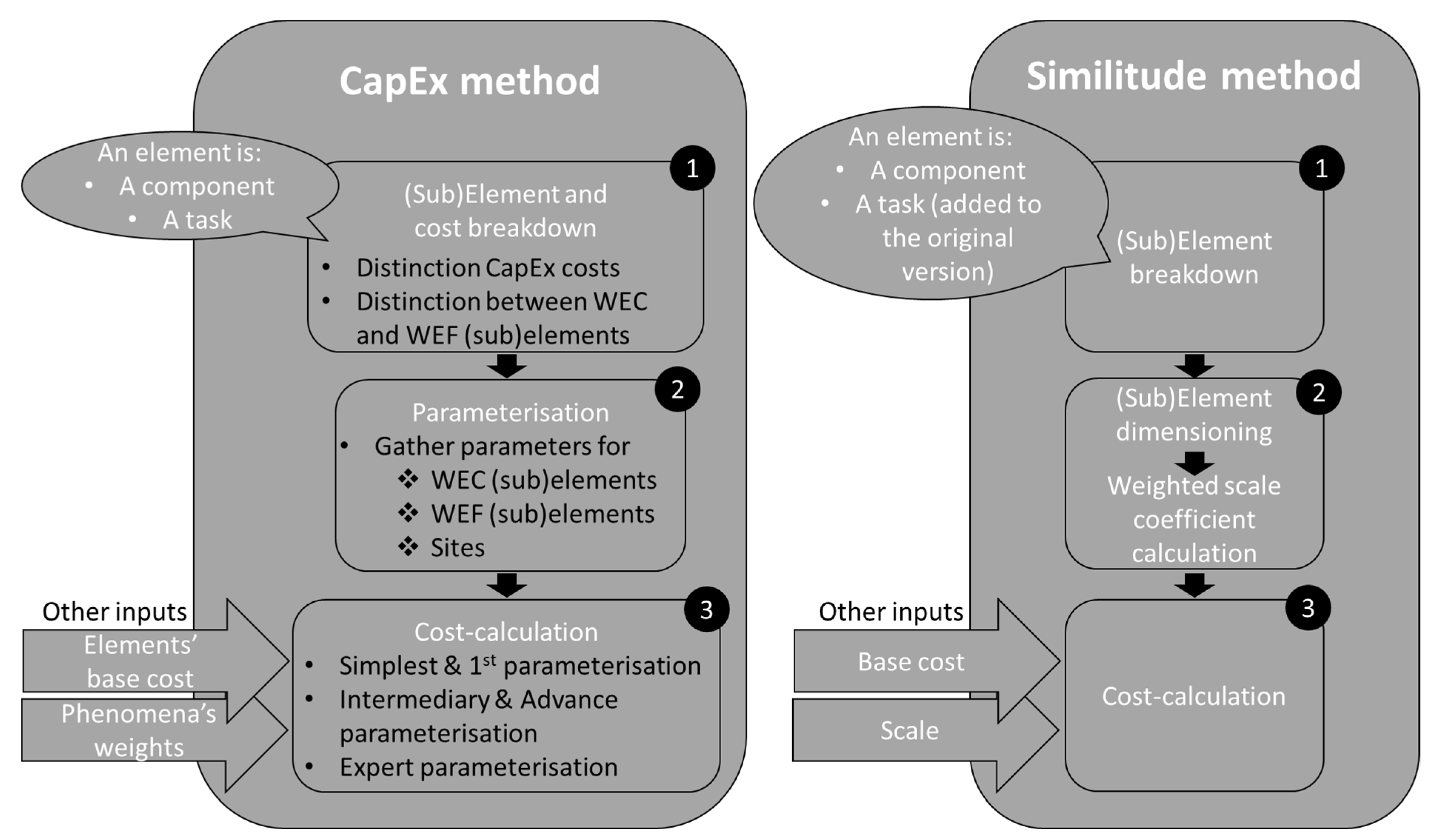

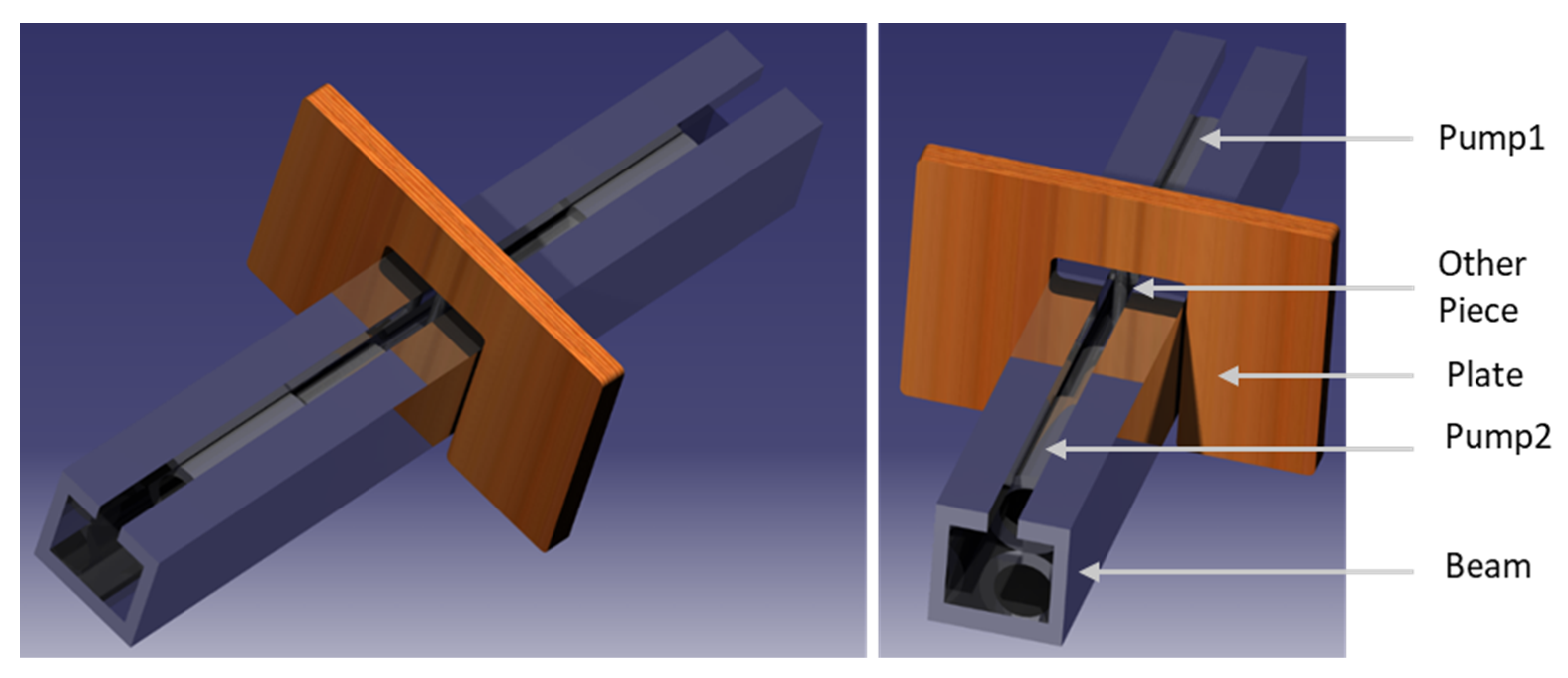
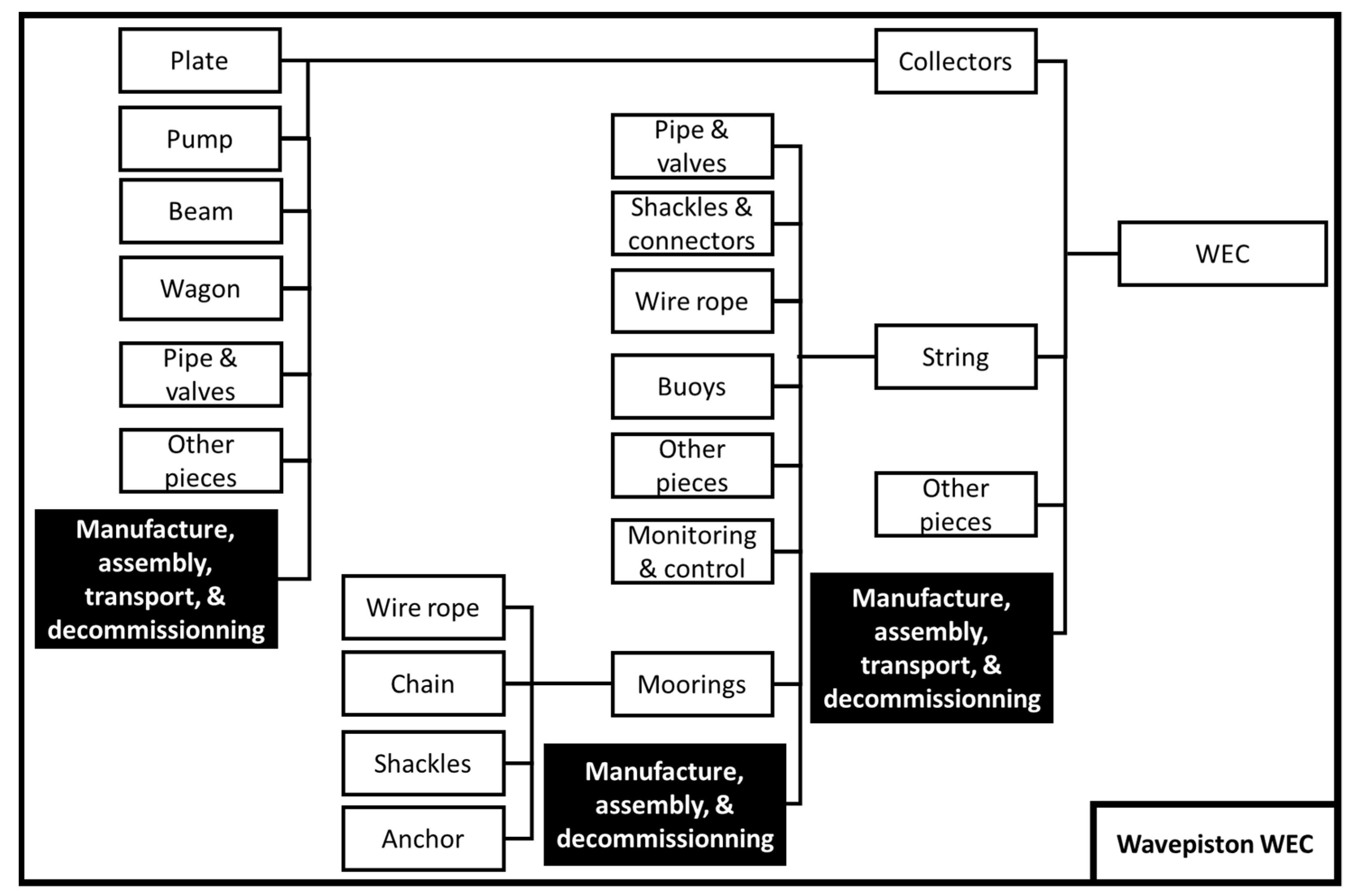
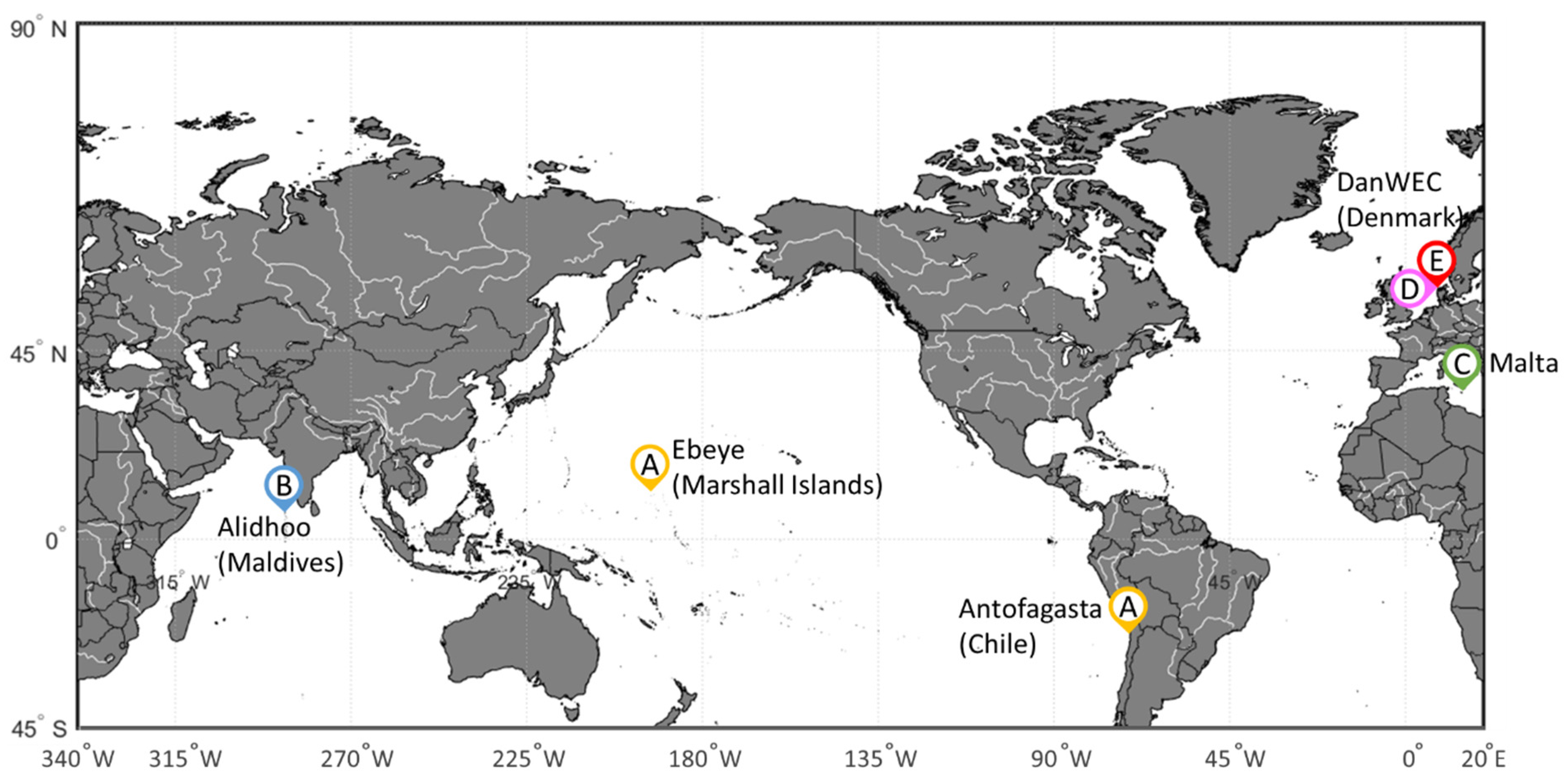
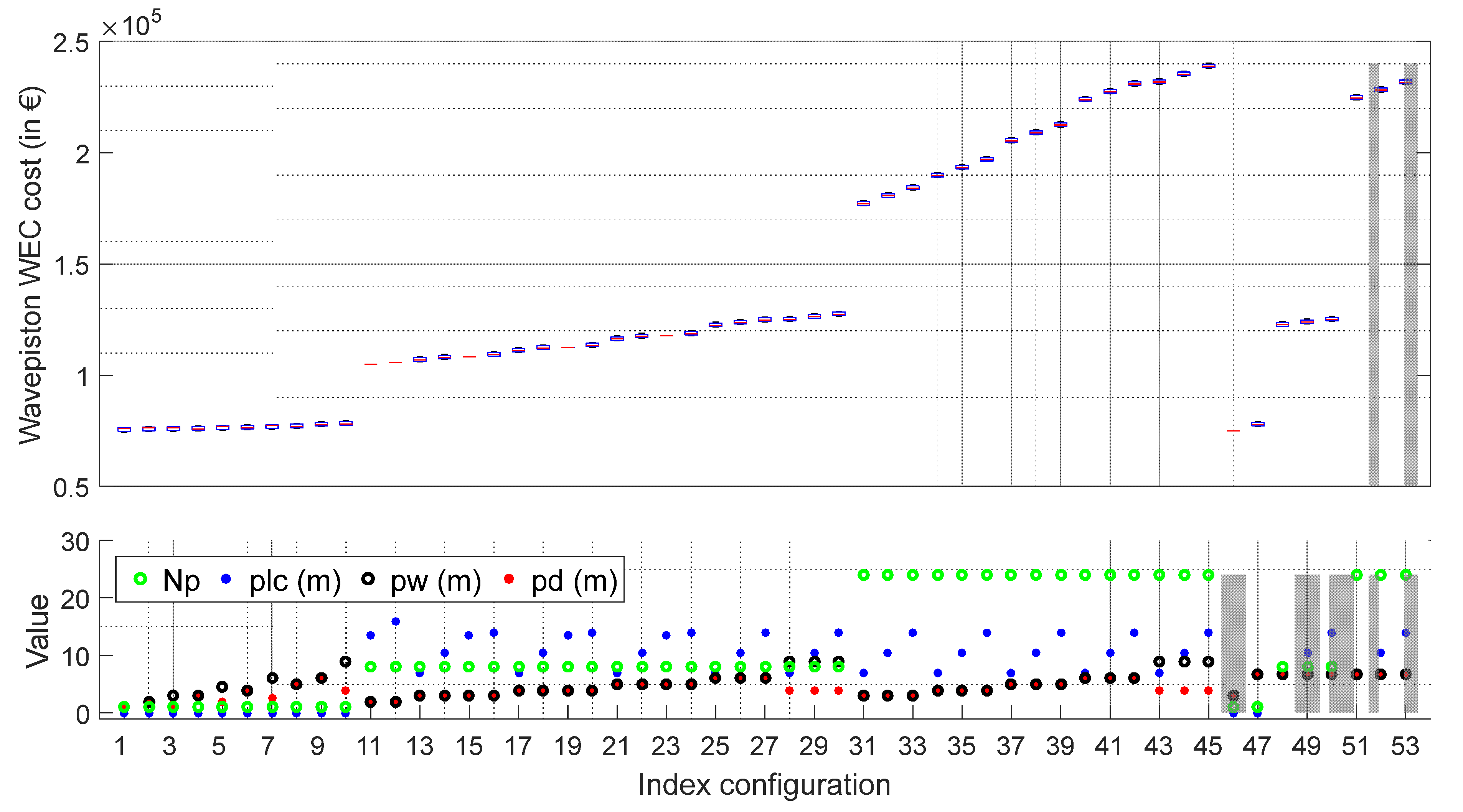
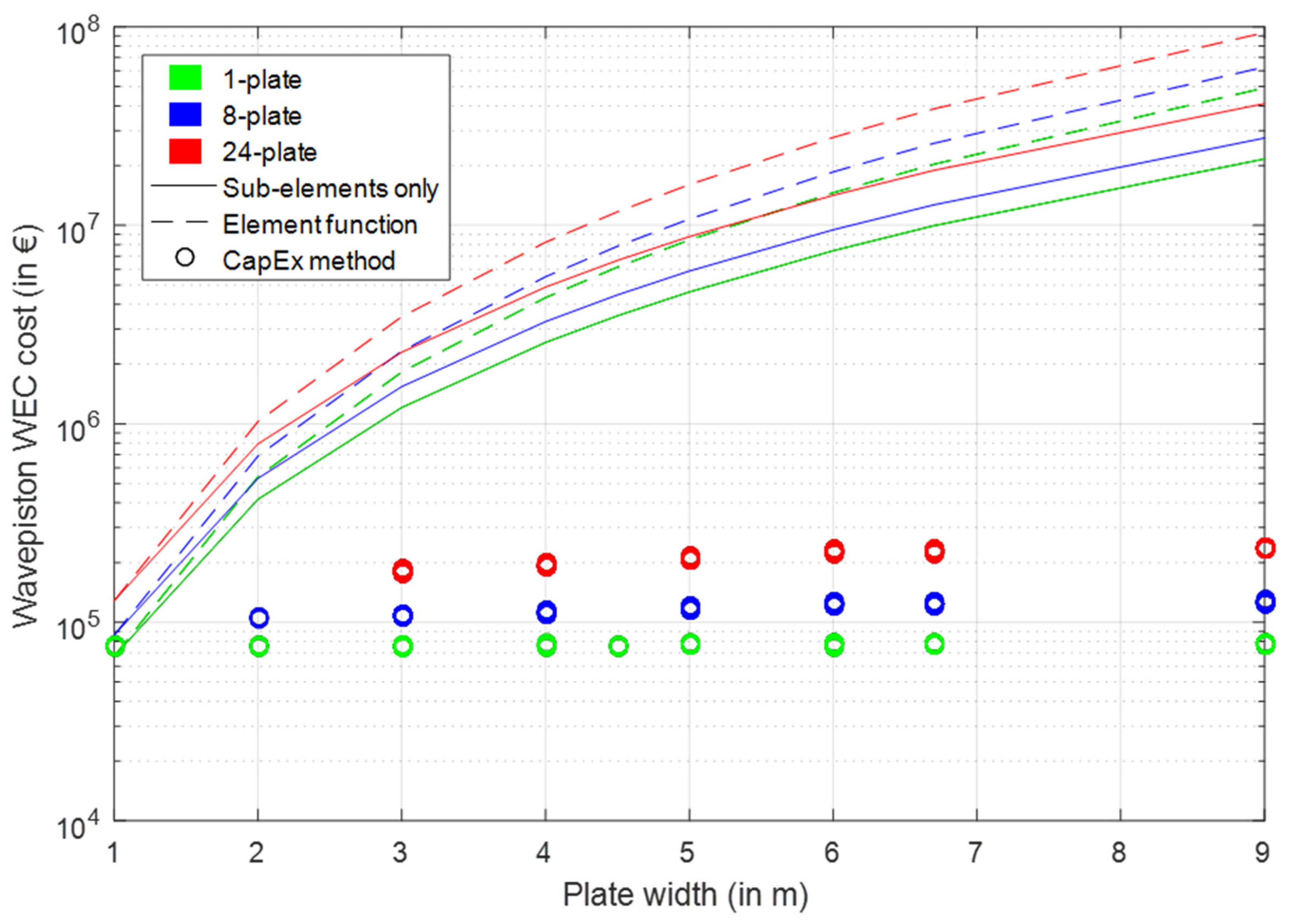
| Function Dimension | Scale Parameter |
|---|---|
| Acceleration | 0 |
| Area | 2 |
| Force | 3 |
| Length | 1 |
| Mass/Volume | 3 |
| Power | 3.5 |
| Pressure | 1 |
| Dimensionless quantity (such as efficiency) | 0 |
| Volume flow rate | 2.5 |
| Plate Shape (ps) | Ellipse | Rectangle | ||||||||||||||||
|---|---|---|---|---|---|---|---|---|---|---|---|---|---|---|---|---|---|---|
| Number of Plates (Np) | 1 | 8 | 24 | 1 | 8 | 24 | ||||||||||||
| Plate Width (pw, in m) | Plate Location Configuration (plc, in m) | 0 | 7 | 10.5 | 14 | 7 | 10.5 | 14 | 0 | 16 | 13.5 | 7 | 10.5 | 14 | 7 | 10.5 | 14 | |
| Plate Depth (pd, in m) | ||||||||||||||||||
| 1 | 1 | −1 & 20 | ||||||||||||||||
| 2 | 2 | −1 & 20 | 20 | 20 | ||||||||||||||
| 3 | 1.5 | −1 & 20 | ||||||||||||||||
| 3 | 3 | −1 | 4 | 20 | 4 | 4 | 4 | 4 | 4 | 4 | ||||||||
| 4 | 4 | 4 | 20 | 4 | 4 | 4 | 4 | 4 | 4 | |||||||||
| 4.5 | 2 | −1 & 20 | ||||||||||||||||
| 5 | 5 | 4 | 20 | 4 | 4 | 4 | 4 | 4 | 4 | |||||||||
| 6 | 2.5 | −1 & 20 | ||||||||||||||||
| 6 | 6 | 4 | 4 | 4 | 4 | 4 | 4 | 4 | ||||||||||
| 6.7 | 6.7 | 4 | 4 | 4 | 4 | 4 | 4 | 4 | ||||||||||
| 9 | 4 | 4 | 4 | 4 | 4 | 4 | 4 | 4 | ||||||||||
| Class of Combination of Site Parameters | Buoy/Hindcast Water Depth (s, in m) | Site Water Depth (d, in m) | Wamit Water Depth (h, in m) | Distance from the Site to Shore (q, in m) |
|---|---|---|---|---|
| A | If s ≥ 200 m | 100 | −1 | 1700 |
| B | Else if s ≥ 75 m | 80 | −1 | 1700 |
| C | Else if s ≥ 40 m | 50 | 50 | 4250 |
| D | Else if s ≥ 25 m | 30 | 30 | 4250 |
| E | Else s < 25 m | 20 | 20 | 4250 |
| Sub-Element Name and Variable | Sub-Element Variable | Base Cost (in €) | Total Factor Name | Factor Weight | Factor Parameter | Comments |
|---|---|---|---|---|---|---|
| Plate | PlTotal cost | 400 | Plate total factor | 60 €/m2 | pa | This factor translates the quantity of material to add to the plate |
| Pump | PuTotal cost | 100 | Pump total factor | 60 €/m | pw | This factor is associated with the scaling of the pipe to engorge more or less flow |
| Other pieces | COPTotal cost | 100 | Other pieces total factor | 20 €/m | pw | This factor expresses increase of the other pieces for more energy extraction in relation to the plate width |
| Beam | BeTotal cost | 400 | Beam total factor | 30 €/m | pw | This factor is associated to the material required per extra meter of plate |
| Total Factor Name | Total Factor Variable | Number of Factors | Factor Name | Factor Variable | Factor Weight | Factor Parameter | Comments |
|---|---|---|---|---|---|---|---|
| String wire total factor | SWTotal factor | 2 | String wire factor 1 | SWFactor 1 | 400 € | Np | This factor expresses the cost impact of the sockets and start-up of the wire production |
| String wire factor 2 | SWFactor 2 | 300 € | Np | This factor translates the cost impact of fishplates and specific non-standard shackles | |||
| String pipe total factor | SPTotal factor | 1 | String pipe factor | SPFactor | 20 € | Np | An additional base cost of 20 € is added to the base cost per meter for the end caps |
| Wavepiston WEC Elements | Function Dimension | Collector Sub-Elements | Function Dimension | String Sub-Element | Function Dimension | Mooring Sub-Elements | Function Dimension |
|---|---|---|---|---|---|---|---|
| Collector | Force | Plate | Area | Pipe and valves | Volume flow rate | Wire rope | Force |
| String | Force | Pump | Pressure | Shackles and connectors | Force | Chain | Force |
| Other pieces | Force | Beam | Force | Wire rope | Force | Shackles | Force |
| Tasks | Mass/Volume | Wagon | Acceleration | Buoys | Force | Anchor | Force |
| Pipe and valves | Volume flow rate | Other pieces | Force | ||||
| Other pieces | Area | Monitoring and control | Power | ||||
| Tasks | Mass/Volume | Moorings | Force | ||||
| Tasks | Mass/Volume |
| Weighted Scale Coefficient Calculation Approach Index | Weighted Scale Coefficient Calculation Approach | Weighted Scale Coefficient Value |
|---|---|---|
| 1 | Average over elements and sub-elements | 2.674 |
| 2 | Average over all the sub-elements | 2.625 |
| 3 | Average of the sub-elements’ averages | 2.866 |
| 4 | Average over the elements | 3 |
| Plate Shape (ps, in --) | Plate Width (pw, in m) | Plate Depth (pd, in m) | Plate Area (pa, in m2) | Collector Total Cost (in €) | Plate Total Factor (in €) | Pump Total Factor (in €) | Beam Total Factor (in €) | Other Pieces Total Factor (in €) |
|---|---|---|---|---|---|---|---|---|
| rectangle | 1 | 1 | 1 | 2370 | 60 | 60 | 30 | 20 |
| rectangle | 2 | 2 | 4 | 2660 | 240 | 120 | 60 | 40 |
| rectangle | 3 | 1.5 | 4.5 | 2800 | 270 | 180 | 90 | 60 |
| ellipse | 3 | 3 | 7.07 | 2954 | 424 | 180 | 90 | 60 |
| rectangle | 3 | 3 | 9 | 3070 | 540 | 180 | 90 | 60 |
| rectangle | 4.5 | 2 | 9 | 3235 | 540 | 270 | 135 | 90 |
| rectangle | 4 | 4 | 16 | 3600 | 960 | 240 | 120 | 80 |
| rectangle | 6 | 2.5 | 15 | 3760 | 900 | 360 | 180 | 120 |
| rectangle | 5 | 5 | 25 | 4250 | 1500 | 300 | 150 | 100 |
| rectangle | 6 | 6 | 36 | 5020 | 2160 | 360 | 180 | 120 |
| ellipse | 6.7 | 6.7 | 35.26 | 5052 | 2115 | 402 | 201 | 134 |
| rectangle | 9 | 4 | 36 | 5350 | 2160 | 540 | 270 | 180 |
| Number of Plates (Np, in --) | Distance between Plates (plc, in m) | String Total Cost (in €) | String Pipe Total Factor (in €) | String Wire Factor 1 (in €) | String Wire Factor 2 (in €) |
|---|---|---|---|---|---|
| 1 | 0 | 18,717 | 25 | 400 | 300 |
| 8 | 7 | 25,472 | 200 | 3200 | 2400 |
| 8 | 10.5 | 26,648 | 200 | 3200 | 2400 |
| 8 | 13.5 | 27,656 | 200 | 3200 | 2400 |
| 8 | 14 | 27,824 | 200 | 3200 | 2400 |
| 8 | 16 | 28,496 | 200 | 3200 | 2400 |
| 24 | 7 | 41,776 | 600 | 9600 | 7200 |
| 24 | 10.5 | 45,304 | 600 | 9600 | 7200 |
| 24 | 14 | 48,832 | 600 | 9600 | 7200 |
| Wamit Water Depth (h, in m) | Mooring Total Cost (in €) Per Site Water Depth (d, in m) | ||||
|---|---|---|---|---|---|
| d = 100 | d = 80 | d = 50 | d = 30 | d = 20 | |
| h ≥ 100 | 55,800 | 55,240 | -- | -- | -- |
| 50 | -- | -- | 54,400 | -- | -- |
| 30 | -- | -- | -- | 53,840 | -- |
| 20 | -- | -- | -- | -- | 53,560 |
| Plate Width (pw, in m) | Weighted Scale Coefficient | |||
|---|---|---|---|---|
| Sub-Elements Only 2.625 | Elements and Sub-Elements 2.674 | Elements Averaged 2.866 | Elements Function 3 | |
| 2 | 416,792 | 431,191 | 492,569 | 540,512 |
| 3 | 1,208,255 | 1,275,080 | 1,574,508 | 1,824,228 |
| 4 | 2,571,123 | 2,751,844 | 3,591,032 | 4,324,096 |
| 4.5 | 3,502,662 | 3,770,558 | 5,032,948 | 6,156,770 |
| 5 | 4,618,613 | 4,997,596 | 6,807,120 | 8,445,500 |
| 6 | 7,453,537 | 8,137,515 | 11,478,809 | 14,593,824 |
| 7 | 9,957,761 | 10,930,484 | 15,748,737 | 20,320,751 |
| 9 | 21,607,372 | 24,063,557 | 36,692,253 | 49,254,156 |
| Plate-Location Configuration (plc, in m) | Number of Plates (Np, in --) | Weighted Scale Coefficient | |
|---|---|---|---|
| Sub-Elements Only 2.625 | Elements Function 3 | ||
| 7 | 8 | 4,985,523,572 | 22,556,997,120 |
| 10.5 | 8 | 14,452,744,628 | 76,129,865,280 |
| 13.5 | 8 | 27,954,682,319 | 161,803,707,840 |
| 14 | 8 | 30,754,913,691 | 180,455,976,960 |
| 16 | 8 | 43,665,996,277 | 269,368,688,640 |
| 7 | 24 | 89,156,716,886 | 609,038,922,240 |
| 10.5 | 24 | 258,460,168,206 | 2,055,506,362,560 |
| 14 | 24 | 549,993,815,757 | 4,872,311,377,920 |
Publisher’s Note: MDPI stays neutral with regard to jurisdictional claims in published maps and institutional affiliations. |
© 2021 by the authors. Licensee MDPI, Basel, Switzerland. This article is an open access article distributed under the terms and conditions of the Creative Commons Attribution (CC BY) license (http://creativecommons.org/licenses/by/4.0/).
Share and Cite
Choupin, O.; Henriksen, M.; Etemad-Shahidi, A.; Tomlinson, R. Breaking-Down and Parameterising Wave Energy Converter Costs Using the CapEx and Similitude Methods. Energies 2021, 14, 902. https://doi.org/10.3390/en14040902
Choupin O, Henriksen M, Etemad-Shahidi A, Tomlinson R. Breaking-Down and Parameterising Wave Energy Converter Costs Using the CapEx and Similitude Methods. Energies. 2021; 14(4):902. https://doi.org/10.3390/en14040902
Chicago/Turabian StyleChoupin, Ophelie, Michael Henriksen, Amir Etemad-Shahidi, and Rodger Tomlinson. 2021. "Breaking-Down and Parameterising Wave Energy Converter Costs Using the CapEx and Similitude Methods" Energies 14, no. 4: 902. https://doi.org/10.3390/en14040902
APA StyleChoupin, O., Henriksen, M., Etemad-Shahidi, A., & Tomlinson, R. (2021). Breaking-Down and Parameterising Wave Energy Converter Costs Using the CapEx and Similitude Methods. Energies, 14(4), 902. https://doi.org/10.3390/en14040902








